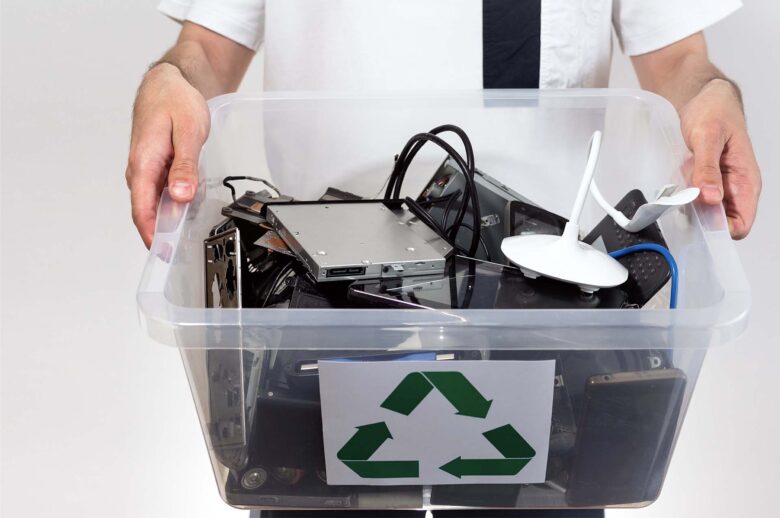Millions of tons of electronics end up in landfills every year, and the amount of e-waste is growing rapidly. As users replace their phones, computers, and other devices more frequently, environmental pollution is increasing. E-waste contaminates soil and water resources, harming ecosystems and human health. Innovative smart technologies are emerging as effective solutions to this global challenge. Digital solutions, such as artificial intelligence (AI) systems that maximize recycling and blockchain networks that track the lifecycle of devices, are transforming the way we manage e-waste. This revolution in e-waste management offers hope for a more sustainable future where technology is the solution.
Smart Technology Overview
The use of advanced waste management technologies is transforming the way we manage e-waste. Smart technologies encompass a wide range of digital developments that improve efficiency, transparency, and sustainability. These solutions address challenges in e-waste management, such as inefficient sorting, supply chain transparency, and tracking through data analytics, automation, and connectivity.
Machine learning algorithms can now accurately detect valuable materials in electronics, while sensor networks can monitor waste streams in real time. Cloud computing enables global collaboration between recyclers, manufacturers, and regulators. These technologies form a complete ecosystem that can address the modern e-waste problem. Smart technological solutions can respond to changing waste trends and regulatory requirements across regions and sectors by using scalable, data-driven approaches that replace manual operations and limited visibility.
Deploying AI to E-waste Management
AI is revolutionizing e-waste processing and management. Modern computer vision systems can identify and sort electronic components faster and more accurately than humans. These AI-powered sorting robots, powered by deep learning algorithms trained on thousands of images, can distinguish between printed circuit boards and rare earth metals, significantly increasing the recovery of valuable materials. Machine learning technology can predict ideal processing options based on previous data, reducing energy consumption and maximizing throughput in recycling facilities.
Natural language processing automates the preparation of compliance reports and regulatory documentation, reducing the administrative burden for waste management agencies. AI-driven predictive analytics can predict e-waste generation, improving resource allocation and facility planning. Some AI systems offer predictive maintenance to extend equipment lifespans and reduce e-waste. Robot-assisted disassembly systems use AI to find the optimal way to disassemble complex devices, preserving critical components. These intelligent systems continuously learn and improve as they process increasing amounts of e-waste.
IoT Tracking and Monitoring
IoT technology is revolutionizing how companies track and manage electronic products throughout their entire lifecycle. Smart sensors in electronic products continuously monitor their usage, performance, and failure points. This data helps manufacturers and service providers implement proactive maintenance measures, extending device lifespans and slowing waste disposal. RFID and GPS tracking devices can track e-waste from collection and processing to disposal or recycling. Real-time dashboards help waste management agencies optimize routes, reduce transportation expenses, and improve processing efficiency.
Recycling facilities use sensors for air quality, temperature, and chemicals to ensure safety and compliance. Smart waste bins, equipped with weight sensors and level indicators, can optimize collection schedules and reduce transport volumes. Cloud-based remote monitoring solutions enable operators to immediately address malfunctions or inefficiencies at individual facilities. Mobile applications connected to IoT networks support responsible waste management by informing users about proper e-waste disposal methods and the nearest collection points. These interconnected technologies form a comprehensive tracking network that ensures accountability and transparency throughout the entire e-waste management process.
Blockchain Brings Transparency to the Supply Chain
Blockchain technology creates an immutable record of the lifecycles of electronic devices and waste management activities, addressing one of the greatest challenges in e-waste management. Blockchain certificates can verify the production, ownership, repair, and disposal or recycling of devices. Transparency can prevent illegal export of e-waste and ensure environmentally sound disposal. Smart contracts automate e-waste supply chain protocols, reducing transaction costs and eliminating intermediaries. Cryptocurrency-based incentive programs offer financial incentives for responsible disposal of electronics.
Blockchain-based certification systems can help recycling companies demonstrate compliance with environmental regulations and strengthen the trust of consumers and regulators. Supply chain participants can share a database of material flows to improve coordination and reduce duplication. Decentralized blockchain solutions are resistant to single points of failure and data manipulation, making them reliable for regulatory reporting and audits. Some blockchain platforms enable consumers to track the environmental impact of their discarded devices, including material recovery and reuse. Transparent systems increase public trust in electronic waste management and ensure accountability for effective oversight and continuous improvement.
Challenges and Opportunities
Smart e-waste management technologies face numerous challenges. High implementation costs hinder the adoption of advanced technologies by smaller recycling companies, leading to regional imbalances in processing. We must strike a balance between transparency and privacy when IoT systems capture accurate data on device usage and user behavior. Interconnected technology platforms limit the benefits of integrated e-waste management solutions. Regulatory frameworks are not keeping pace with rapidly evolving technologies, leading to unclear compliance obligations and standards.
A skills shortage in the labor market requires extensive training to use advanced AI and blockchain technologies. These barriers present opportunities for innovation and growth. Government incentive programs can reduce the costs of technology adoption and offer advantages to early adopters. Developing international standards can improve interoperability and expand the smart e-waste sector. Education can foster technical skills for operating and maintaining complex systems. Public-private partnerships can accelerate technology adoption and maximize environmental benefits. Smart technologies are becoming more affordable and accessible to businesses of all sizes, leading to a more comprehensive and efficient global e-waste management network.
Towards a Sustainable Digital Future
Smart technologies are transforming the way we process e-waste. AI, IoT, and blockchain systems offer unprecedented opportunities for reducing e-waste and recovering valuable resources more efficiently. The adaptability of these technological solutions to regional needs and regulations enables global adoption. To create an ecosystem that can comprehensively address the e-waste problem, technology innovators, waste management companies, governments, and consumers must collaborate.
Research, infrastructure, and education will stimulate the development of these promising technologies and cultivate the talent needed to use them. Smart technologies contribute to a circular economy, allowing electronic devices and their components to last longer as they become more advanced and affordable. Improved waste management methods and intelligent systems can prevent waste, extend product lifecycles, and maximize resource recovery, creating a sustainable technology ecosystem—the future of e-waste management.
FAQs
1. Smart technologies can reduce e-waste, but how?
Predictive maintenance, IoT monitoring, and AI optimization can reduce e-waste by extending device lifespans, preventing malfunctions, and improving efficiency. These technologies can extend the lifespan of electronic products.
2. What are the advantages of AI over traditional e-waste sorting?
AI sorting systems detect materials and components faster and more accurately than manual sorting. They can distinguish subtle differences between materials with similar appearances, operate without fatigue, and improve over time thanks to machine learning.
3. Is implementing a blockchain system for e-waste management expensive?
The size and complexity of the system influence the implementation cost. Blockchain infrastructure can automate processes, eliminate intermediaries, and improve supply chain efficiency, but implementation requires a capital investment.
4. Can IoT sensors help people dispose of electronics properly?
IoT systems can inform users about device maintenance, provide recycling information, and create incentives for proper disposal. Smart bins and tracking systems can help consumers find waste disposal locations.
5. What is the impact on privacy when IoT devices track e-waste?
To ensure privacy, the system design must anonymize personal data while maintaining the traceability of waste management. To balance privacy and openness, many systems track devices instead of users.




